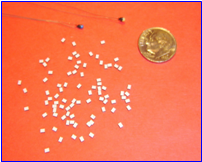NTC Application Notes
VERITAS SENSORS L.L.C.
1115 Inman Avenue #361
Edison, NJ 08820
Tel 908-822-9778 Fax 908-822-9779
Veritas Home
Temperature Overview
NTC Application Notes
NTC Products
Veri-Stable NTC’s
mail: 1115 Inman Avenue #361
Edison, NJ 08820
To obtain an answer to a simple technical question on any of the products or services listed on this site (at no cost or obligation to you), please submit your inquiry to: info@veritassensors.com
HOME page
To contact us:
NTC Thermistors are thermally sensitive resistors with a large, Negative Temperature Coefficient of resistance.
They are manufactured using combinations of metal oxide powders and then combined with organic compounds to create the desired geometry. Next the devices are sintered at high temperatures to form dense ceramic structures with the thermal and electrical properties of semiconductors. Because of the large number of material compositions and geometries, NTC thermistors are available in an almost limitless array of sizes, resistance values and resistance characteristic curves. Of course, there are limitations in the useful temperature range for each type of device that are imposed by the materials used in their construction.
NTC thermistors can be grouped into two distinct categories based upon the way that electrical contacts are attached to the ceramic body. These categories can be further broken down into specific types based upon the final geometry of the device, the protective coatings applied and the means by which the device is connected to external circuitry.
The image at left shows the first major category of NTC devices wherein the electrodes are fired onto the surface of the thermistor body.
Included in this category are such devices as:
· Chips (with leads or leadless; coated or bare)
· Disks (with leads or leadless; coated or bare)
· DO35-package (axial leads or end caps)
· SMD’s (edge band electrodes)
· Rods (axial leads or end caps)
· Washers (leadless or with mounting clips)
· Thick-film (fine wires, mounted; electrodes, un-mounted).
These devices may be soldered, bonded or welded directly to electrical circuits or they may have external wires attached to them by soldering or welding. Coatings are usually added to provide mechanical and environmental protection. The coating can be a dip into epoxy, phenolic, varnish or plastic; encapsulations in glass; or a passivation layer of glass. The maximum operating or storage temperature of the device depends upon the method of electrical contact and the material used for the coating. Typically, these devices are limited to a maximum temperature of approximately 150 °C (302 °F).
The image at right shows the other major category of NTC devices wherein the electrodes are platinum alloy wires that are sintered directly into the body of the thermistor.
Included in this category are such devices as:
· Beads (bare beads and glass encapsulated beads)
· Probes (beads in solid glass tubing with radial leads)
· Rods (beads in solid glass tubing with axial leads)
· Bead-in-Glass Enclosures (beads in hollow capsules).
Bare thermistor beads are used in some special applications, however, most of the devices in this category are sealed in glass for maximum protection and long term stability in harsh environments.
Probes and Rods consist of bead thermistors made with fine gauge platinum alloy wire and subsequently welded to extension leads of a larger diameter glass-to-metal sealing alloy (such as Dumet). The weld joints are sealed into the glass body. Glass sealed thermistors in this category typically have a maximum temperature rating of up to 300 °C (572 °F) and sometimes higher for special applications. NTC Thermistors are most commonly and effectively used in applications where the overall temperature range does not go below a minimum of –80 °C (-112 °F) nor above a maximum of +260 °C (500 °F).

ASSEMBLIES:
Many applications involving NTC Thermistors call for them to be attached to a significant length of electrical cable or hook-up wires and to be further encapsulated into a protective enclosure.
The design of a temperature sensor assembly must be optimized for contact with a solid surface; for immersion into a fluid; or for exposure to gas/vacuum. The proper design of such assemblies is not trivial. The selection of the thermistor, the dimensions of the enclosure as well as the temperature ratings and dielectric properties of the encapsulation materials are all extremely important for best stability and performance.
Immersion sensor Typical housings Hypo needle sensor
Small bead sub-assembly ----- Tip (0.5 x 2.0 mm)
Assembly Options:
· Body material Metallic = Stainless steel, Aluminum, Brass, Copper, Inconel, etc.
Non-metallic = Plastics, Elastomers, Epoxies, Laminates, etc.
· Body shapes Tubular = open tip, closed tip, shaped tip, perforated tip, etc.
Solid = rectangular, machined, molded, cast, etc.
· Mounting type Screw thread, Flange & bolt, Adhesive, Clamp, etc.
· Insulations Rigid = Plastics, Ceramics, Epoxy, etc.
Flexible = Elastomers, Tape/Film, Fiberglass, etc.
· Extension leads Cable = Shielded, Un-shielded, Ribbon, etc.
Wire = Hook-up, Magnet, Flex Circuit, etc.
· Terminations Cut/stripped, Terminals, Plugs, Receptacles, Connectors, etc.
Contact our Applications Engineering Department to obtain assistance in determining the proper sensor assembly for your application.